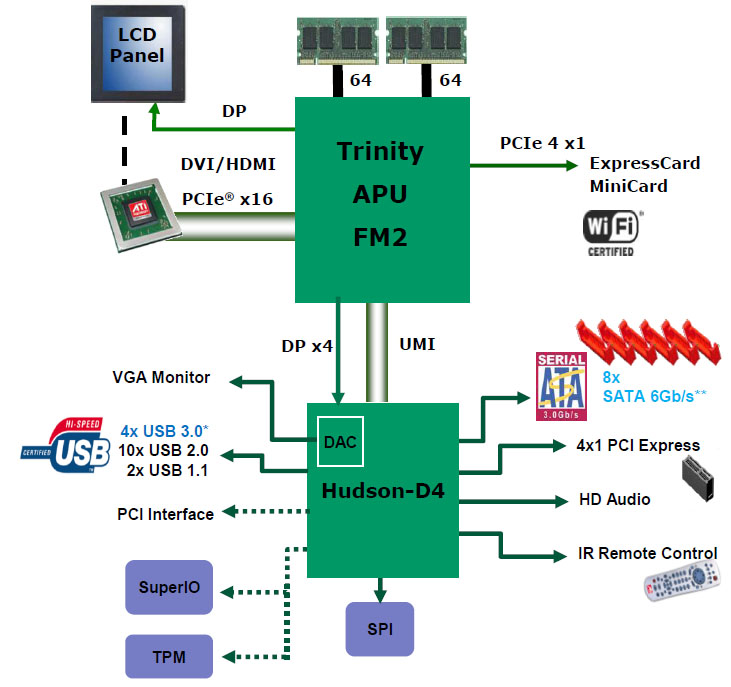AMD Trinity On The Desktop: A10, A8, And A6 Get Benchmarked!
Socket Compatibility And The A85X FCH
Want Trinity? You Need A New Motherboard
Perhaps the biggest downer for early adopters of AMD’s Fusion initiative is the quickness with which the company is deprecating support for the Socket FM1 interface used to enable desktop-class Llano APUs. In much the same way that Intel replaced LGA 1156 with a very similarly-sized LGA 1155, AMD’s existing 905-pin socket is giving way to a 904-pin one.
Presumably, changes to the FM2 interface came about due to power delivery, since the PCIe and DDR3 I/Os shouldn’t be any different. Whatever the reason, though, Llano-based APUs won’t drop into FM2-equipped boards, and Trinity-based APUs won’t work in platforms with Socket FM1. As you can see in the image above, Socket FM2, on the left, and FM1, on the right, are keyed completely differently.
Meet The New A85X FCH
Although Trinity-based APUs are not socket-compatible with Llano, there’s nothing precluding motherboard vendors from attaching existing Fusion Controller Hubs to the new processor’s four-lane UMI interface. We actually have two FM2-equipped motherboards in the lab: ASRock’s FM2A75 Pro4 and a platform based on A85X, formerly referred to as Hudson-D4.
In reality, the two chipsets are pretty hard to tell apart. Basically, A85X gives you eight SATA 6Gb/s-capable ports, RAID 5 support, and the ability to divide the APU’s 16 lanes of PCI Express 2.0 into a pair of x8 links.
Otherwise, you’re looking at the same combination of USB 2.0 and 3.0 ports (4 + 10), the same four-lane Unified Media Interface, four lanes of second-gen PCIe, and four-channel audio (along with FIS-based switching, mSATA support, legacy PCI, and so on). AMD has not yet added PCI Express 3.0 support to any of its platforms, and isn’t expected to for some time.
Get Tom's Hardware's best news and in-depth reviews, straight to your inbox.
More than likely, you’ll look to A75-based boards with Socket FM2 interfaces to save a little money, or A85-based platforms as a more feature-complete step up.
Current page: Socket Compatibility And The A85X FCH
Prev Page Memory Bandwidth Scaling: Feed The Beast Next Page Test Setup And Benchmarks-
Youngmind This is so exciting! AMD is probably going to dominate the lower-end and give the poor gamers like me more bang-for-buck as their IGP get better and better :)!Reply -
dudewitbow depending on how its priced, its a really nice alternative for bare budget gaming that opens up a quad core as wellReply -
So this means that a 'Crossfired' Trinity APU would beat ANY similarly-priced Intel (CPU+discrete GPU) ???Reply
Well at least in gaming -
dudewitbow JiggerByteSo this means that a 'Crossfired' Trinity APU would beat ANY similarly-priced Intel (CPU+discrete GPU) ???Well at least in gamingReply
really the question is what gpus are able to hybrid crossfire with it. the information was never public. not all amd gpus will hybrid crossfire with it. -
Well, where are the Ivy/Sandy i5's and i3's???Reply
Once they are pitted against each other, that will be A TRUE measure of the APU Trinity's marketability -
mayankleoboy1 in the OpenCL Winzip benchmark, when openCL is enabled the workload is done only by the iGPU or the CPU as well ?Reply
i mean what is the processor usage during the benchmark ? are all CPU cores used? or only one? -
cangelini mayankleoboy1in the OpenCL Winzip benchmark, when openCL is enabled the workload is done only by the iGPU or the CPU as well ?i mean what is the processor usage during the benchmark ? are all CPU cores used? or only one?Good question--I'll take a look for you.Reply


